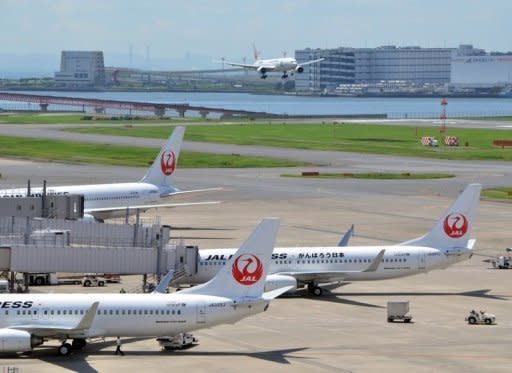Japan Airlines riding high on Tokyo bourse relisting
Japan Airlines marked a spectacular return from bankruptcy when its shares soared in early trade after relisting in Tokyo Wednesday, three years after it became one of the nation's worst ever failures. The carrier jumped to 3,905 yen, up 3.03 percent on the offer price, minutes after the opening bell following an offering that raised around $8.5 billion, the second biggest in the world this year after Facebook. It lost a little altitude later, but remained at a premium to the offering, closing at 3,830 yen, up 1.06 percent. JAL's rebirth marked a stunning turnaround for the airline after it crashed into insolvency, owing 2.3 trillion yen ($29 billion), one of Japan Inc.'s most costly corporate meltdowns. "Without being carried away by today's share price, we will make efforts in continuing solid management so that investors will support us for a long period of time," company president Yoshiharu Ueki told a news conference. Back under the scrutiny that comes with being a publicly-listed business, JAL will face demands from a variety of shareholders. But Ueki, a charismatic former pilot and the son of a storied kabuki actor, said the company would be focusing on profits rather than size and would be a good bet for investors. "We will actively return profits to our shareholders by continuously paying dividends," he said. "We will make efforts so that we will be the first choice for customers among airlines." The embattled company had continued flying while it went through a rehabilitation process under court protection after the calamity of three years ago. The carrier, recently touted as the world's most profitable airline, received a huge government bailout and other concessions, drawing howls of protest from rivals including All Nippon Airways (ANA). Last month, JAL pointed to its improved financial health, saying net profit in the April-June quarter more than doubled on-year to 26.9 billion yen. Ueki said the current precarious relations between Japan and China, embroiled in a worsening spat over disputed territory, would not have too much impact on the airline. He said managers had experience of dealing with a sudden fall in passenger numbers, citing the demand drop-off after the earthquake and tsunami that laid waste to a large stretch of Japan last year. "We already have a core structure in place enabling us to act quickly," he said. The turnaround, which saw the former flag carrier drastically shedding excess weight, was led by businessman Kazuo Inamori, who was brought in by the government. Under Inamori, JAL withdrew from unprofitable routes and sold or merged non-core businesses. Inamori said Wednesday he plans to step down as honorary chairman and completely withdraw from JAL's management early next year. In a regulatory filing earlier this month, the airline said it expected to sell 175 million new shares at 3,790 yen each, resulting in proceeds of 663 billion yen. That is nearly double the amount of public money spent to keep it afloat during the huge restructuring, with the proceeds on Wednesday used to pay back the government bailout. The offering was the year's second-biggest globally behind Facebook, after the social networking giant's $16 billion IPO in May, although Facebook shares have dived since their much-hyped debut. Tony Tyler, director general of the International Air Transport Association, in Tokyo said JAL's journey from basket case to global competitor was a cause for celebration. "We get reminded of the resilience of the aviation industry, and the government and everybody involved should be congratulated on the quick process," he said. The Japanese airline has embarked on an ambitious expansion, saying earlier this year it ordered 10 new fuel-efficient Boeing 787 Dreamliner aircraft as it looks to build on its recovery and fend off an emerging low-cost sector. The 10 new aircraft, part of a five-year plan, are in addition to an existing order for 35 of the mid-sized planes capable of flying long-range routes. Japan was slow to the budget carrier sector although several new low-cost airlines have come online this year. It remains unclear how much they will eat into their bigger rivals' profits.




